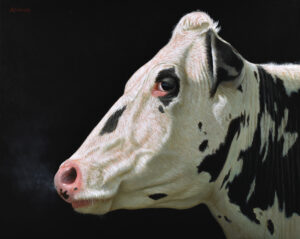In recent years, Alexandra Klimas has become known for her hyperrealistic portraits of barnyard animals, mainly cows. We excitedly share that Alexandra recently won Best in Show at the All Animals Art Awards organized by the Camelback Gallery for her painting Susanne the Cow – the original painting can be seen at our gallery in New York.
By creating close-up portraits of barnyard animals, Klimas transcends some of the old conventions of animal painting. Unlike the work of her predecessors, like Rosa Bonheur and David Shepherd, Alexandra frames her subjects in a way that allows us to view them not as beasts of burden or food sources but as living beings with individuality and personality. Klimas’s intentional focus on barnyard animals is a reflection of a larger goal of recognizing and respecting animals that she sees as forgotten. “Pets are pampered and adored, but we are spared of images of animals for the meat industry. […] I try to paint my cows so lifelike that they look at you and a kind of intimate relationship is created.” Like with her other animal portraits, Klimas based Susanne on a real cow she observed at the Dutch farms she frequently visits in the summertime. During these excursions, she writes brief descriptions beside her sketches, commenting on the animals’ temperament and identity.
Even when we aren’t looking at the animals face-to-face, they are still painted as individuals rather than members of vast herds. Klimas may paint the cows Lieke and Aline in the field against the sky’s great blue and white expanse, yet Alexandra shows them not as indistinguishable parts of a larger whole but as two unique living beings. With Susanne, though, Klimas gives us an incredibly intimate look at the cow. Unlike her other cow paintings, Klimas shows Susanne in profile against a completely black background. The subject in profile against a monochromatic background gives off the feeling of Renaissance portraiture, namely the style popular among fifteenth-century women in Tuscany. It indicates Klimas engaging in a dialogue that transcends a mere depiction of animals. It hints at something more profound, something that attracts people to her work.

